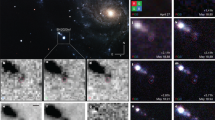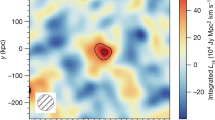Abstract
IT is nearly 20 yr since M82 was accepted as the archetypal exploding galaxy. Its most spectacular feature is the system of luminous Hα filaments radiating from the core of the galaxy in the direction of the minor axis (ref. 1 and K.T. and D.J.A. in preparation), and the discovery of a velocity gradient within these filaments led to the conclusion that ionised material had been ejected from the nucleus at approximately 103 km s−1 by a cataclysmic explosive event some 106 yr ago2. A later and more extensive spectroscopic study refined and generally confirmed the explosion hypothesis3. It had been assumed that the emission was intrinsic to the filaments, but additional radio and optical data cast doubt on this assumption and hence the whole concept of an explosive event. The well ordered symmetrical pattern exhibited by the broad band polarisation measurements4 was interpreted as a consequence of reflection of the light from the main body of the galaxy by an extensive halo of dust particles5. Furthermore, the emission lines were also found to be polarised identically to the continuum6,7; this strongly implied that they were also seen in reflection and, therefore, the observed velocity differences had to be reinterpreted in terms of motions of the scattering particles. An explosion model then becomes most unlikely, because then the dust would scatter exclusively redshifted light, whereas both blue and redshifts are observed8. M82 is enveloped in a giant HI cloud which engulfs the whole of the M81 group9,10 and Solinger et al.11 therefore suggested that M82 is merely an interloper in the group, moving through this dusty HI cloud in such a way that its drift velocity accounts for the observed Doppler field seen in reflection. We draw attention here to some spectacular new spectroscopic data, which we believe to be irreconcilable with these more recent scattering models and which naturally lead us to resurrect an expulsion hypothesis.
This is a preview of subscription content, access via your institution
Access options
Subscribe to this journal
Receive 51 print issues and online access
$199.00 per year
only $3.90 per issue
Buy this article
- Purchase on Springer Link
- Instant access to full article PDF
Prices may be subject to local taxes which are calculated during checkout
Similar content being viewed by others
References
Sandage, A. R. & Miller, W. C. Science 144, 405–409 (1964).
Lynds, C. R. & Sandage, A. R. Astrophys. J. 137, 1005 (1963).
Burbidge, E. M., Burbidge, G. & Rubin, V. C. Astrophys. J. 140, 942–968 (1964).
Bingham, R. G. et al. Nature 259, 463–465 (1976).
Solinger, A. B. & Markert, T. Astrophys. J. 197, 309–315 (1975).
Visvanathan, N. & Sandage, A. R. Astrophys. J. 176, 57–74 (1972).
Visvanathan, N. Astrophys. J. 192, 319–324 (1974).
Heckathorn, H. M. Astrophys. J. 173, 501–527 (1972).
Davis, R. D. I.A.U. Symp. 58, 119–128 (Reidel, Dordecht, 1974).
Correll, G. A. Mon. Not. R. astr. Soc. 178, 577–589 (1977).
Solinger, A. B., Morrison, P. & Markert, T. Astrophys. J. 211, 707–717 (1977).
Wyckoff, S., Wehinger, P. A., Fosbury, R. A. E. & McMullan, D. Astrophys. J. 206, 254–256 (1976).
Author information
Authors and Affiliations
Rights and permissions
About this article
Cite this article
AXON, D., TAYLOR, K. M82: the exploding galaxy?. Nature 274, 37–38 (1978). https://doi.org/10.1038/274037a0
Received:
Accepted:
Published:
Issue Date:
DOI: https://doi.org/10.1038/274037a0
This article is cited by
-
Large-scale bipolar wind in M82
Nature (1988)
-
Emission line velocity field in the central region of M82
Astrophysics and Space Science (1986)
Comments
By submitting a comment you agree to abide by our Terms and Community Guidelines. If you find something abusive or that does not comply with our terms or guidelines please flag it as inappropriate.



